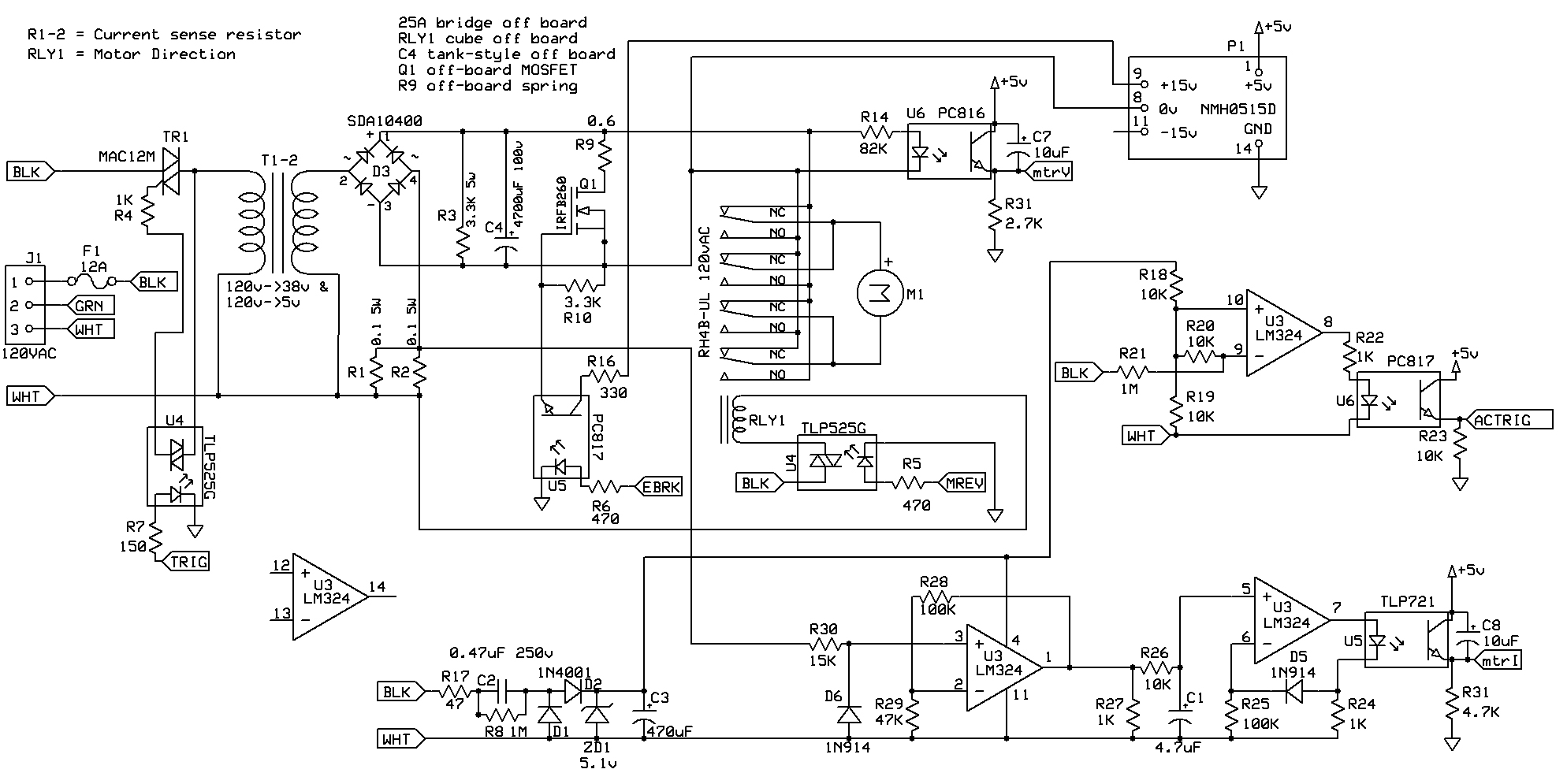Tech Forum
-
Tech Forum
-
Questions
March 2014
I am using an Ametek 965922-101 brushed DC motor (rated 38V nominal, 12A peak) in a project that runs it as both a drive and a brake. (Interestingly, the 38V rating is a "bus rating," i.e., with the motor stalled at 38V, it will use 12A and get nothing done.) In drive mode, the controller typically runs it up to 60V; current limited to 10A. Works great.
For the brake, I am using an IRFB260 MOSFET with a 0.6 ohm spring in series to limit the surge current. The PWM rate is 120 Hz. (NOTE: When sinking 1/2 HP of energy, the motor generates 30V.) However, each time the MOSFET turns off (at 120 Hz), the motor provides a huge kickback, and the MOSFET's reverse-protection zener diode probably will not survive that for very long.
At first, I paralleled the motor with an Elite 100 µF 400V capacitor [marked PM 105°C, (M 9305)] which calmed down the splash nicely. Then one day after some generous usage, a huge cloud of smoke boiled out of a severely melted capacitor. It was a very abrupt introduction to the (unmarked) ripple current rating on capacitors. At the moment, I'm just using the same 4,700 µF 100V bolt-mounted huge capacitor that filters the drive circuit. (When using the 100 µF capacitor, one of the relay contacts would switch the 4,700 µF capacitor out of the circuit.) However, the 0.64 ohm brake circuit discharges the capacitor so quickly (at 120 Hz) that brake control is either none or a lot.
The challenges are that the kickback is positive, it needs to be kept under 200V, and there is a lot of energy behind the kick from this motor. I ended up with 100 µF in the first place because a large (non-electrolytic) 10 µF capacitor did very little to the splash, which almost immediately would go beyond the 250V rating of the oscilloscope. In my parts bin are some large diodes such as DTV32, STPR1020CT (2), STPR2045CT (2), TYN058, and others, if that helps. I've read a little about snubber circuits, but would like some technical advice.

On the schematic in Figure 1, the +5V and ground points belong to an isolated 5V 1A cell phone charger. Not shown is the PIC16F747 and associated circuitry that handles the controlling.
#3141
Tsidqah
via email
Please log in to post an answer.
Answers
Quickly braking an electric motor requires a circuit that will quickly dissipate quite a bit of energy. Texas Instruments has produced a paper, "The Art of Stopping a Motor," available at http://e2e.ti.com/blogs_/b/motordrivecontrol/archive/2013/10/18/the-art-of-stopping-a-motor.aspx. TI also has motor control dev kits that offer braking circuits and techniques that might help in Tsidqah's circuit. The kit documentation usually includes code and circuits. The Microchip Technology application note, AN-905, "Brushed DC Motor Fundamentals," offers a way to provide a shunt to ground that brakes a motor: http://ww1.microchip.com/downloads/en/AppNotes/00905B.pdf.
I suggest the designer replace the 4PDT relay with a MOSFET H-bridge circuit that offers more flexibility for various braking applications. Also, real time voltage and current measurements taken during braking with a load resistance should help determine the characteristics needed in a braking load and switching circuits. As for a testing load, consider a non-electronic clothes iron or a toaster oven.
Jon Titus
Herriman, UT
If I assume that RLY1 is not connected to short out the power supply and is shown de-energized, when RLY1 is energized, the motor connections will be reversed and the motor (acting as a generator) will try to drive the positive rail of the supply more positive. C4 will soak up some of the reverse current and when Q1 is turned on, it will limit the voltage to about 12 volts (1 ohm x 12 amps). Input to the power supply has to be turned off at this time.
There are two problems: During the transition time of RLY1 when the motor is not connected to anything, the voltage will shoot to the moon, possibly damaging the motor, and the delay time in PCB17 may not turn on Q1 in time to limit the voltage below 200 volts. One solution is to connect a 12 amp diode and series resistor across the motor to limit the voltage to 200 volts (R = 200V/12A = 16 ohms). A 75 watt light bulb would no doubt work as the resistor.
Russell Kincaid
Milford, NH
I'm not sure what you are doing with the 4PDT relay as shown, so maybe it is a drawing error. The way it is shown, the motor feed and motor are both shorted! For motor reversal you only need a 2PDT relay. If you are paralleling contacts for increased current, that's a bad idea since there is no guarantee the contacts will open or close in unison, so in effect, one contact will still carry the load. Paralleling for redundency is also not good because if a contact welds itself, bad things can happen when the parallel contact switches.
I assume since there is no logic flow provided, that the 'TRIG' signal goes low before the 'EBRK' signal goes high, and what about some protection for the input to the opto-isolator U6. Likely the spike is exceding LED PRV rating. I would think clamping diode(s) would help with the CEMF and perhaps an R/C as well. Hope this helps!
Len Powell
Finksburg, MD

